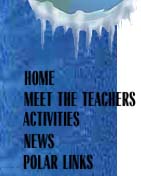
|
|
TEA Collaborative Learning Group
Overview of Plan
Nelson
Back to Login Page
Team Members:
Who and how to recruit
I am fortunate to be in a K-12 school, and therefore will be able to recruit from a wide grade-range of teachers. As my school is small (approximately 600 students), it is to my advantage to be able to draw from multiple grade levels. I plan to start the process by giving a brief presentation at the first full faculty meeting (August). This will serve to open the door to all interested persons, and I will parcticularly stress that all grades and any discipline will be welcome to parcticipate. There are many ways to incorporate science into language arts, social studies, and math classes – especially in the elementary grades. There is no reason for these folks to be left out. My hope it to get committed teachers from my own school, but if that doesn’t work…I also plan to recruit at the district level. I will contact the county school system science specialist and the city school system science specialist and find out when I could present to each group – perhaps at one of their required in-service meetings. My school has a Director of Communications, so it is my intention to use be in close contact with him. Our press arcticles will discuss the importance of outreach in education. I also will use my website to spark interest. There are some area private schools with whom I can network. These schools are on a schedule similar to ours, which is an advantage when planning meeting times. Science teachers first will certainly be my first “target.” However, I will encourage math, geography, social studies teachers if there are not enough science teachers who are interested in committing. Research is not limited to the natural sciences – social studies, geography, cultural studies, and math/data analysis are easy areas to incorporate in a project such as this.
What is your role within your team?
My primary role will be as a facilitator and promoter of inquiry-based learning. Teachers need to be in control of their own curriculum and implementation. In addition, it is my responsibility to keep things on track and moving in a positive direction, to keep communications open and current, to keep accurate records, and to make sure that the members do not become overwhelmed by logistical matters.
What professional growth goals do you and your team members hope to reach through this partnership?
One goal is to build a collaborative learning community with inquiry learning and research as the core theme. Promoting polar research and polar science is another fundamental goal.
How will you and your team reflect on these goals and on learning and classroom practice (e.g., pedagogy, the use of technology, content, the process of science)?
REMEMBER: This outreach is to focus on the process of science research/inquiry/learning/collaboration/community of learners/life-long learners as set forth by the National Science Foundation. I am to use the polar research experience as a springboard/model for research and learning experiences.
Milestones for assessment
During the planning stage, it is important to set up a calendar with assessment checks at regular intervals for both mentees and their students.
Decide on critical due dates and stick to them
Planning stage
Research stage
Data collection stage
Collaboration and synthesis stage
Analysis stage
Interpretation stage
Communication/sharing of results
Technology Component
Content
Process of Science
Mentoring Plan (Revised from Orientation)
Topic of interest/defining topic of interest
It is sometimes easier to define topics than to develop a truly in-depth plan and ultimately stick to it. Depending on grade level and subject area of the mentees, it will be important to discuss potential uses of research-based learning and where it will fit in to their parcticular curriculum. Topics need to be well-defined, but not restrictive or exclusive. Our first task will be to meet and look at the scope of curriculum at each level and determine potential areas for collaborative learning and areas appropriate for process-oriented (research) projects.
Ideas/major goals for first year of collaboration
Meetings to determine topics and projects
Research
Refining plans and writing project outlines/timelines
Ways to implement the research
Design website
Design newsletter
Strategy for ways to follow/add to research from year-to-year
Tentative outline of first session
Introductions
Brainstorm reasons for doing this
Why does each person want to do it
Reiterate the goals and objectives of the program – make sure that folks are clear about what they are getting into
Timeline
“Assignments” – webpage, newsletter, press/media, resources
Strategies for involving team members and for sustaining involvement
Possibly have each team member be responsible for one aspect – ex. Webpage, newsletter, research professional development opportunities, grants and funding, logistics, finding community (research) projects (stream data collectors for SOS, seasonal bird counts for Audubon Soc., ATBI)
Skills and resources to support team work; skills and resources to strengthen or develop resources
Technology for communication – possibility for training
Research skills
Administrative support for project and for release time
Work with school librarian
Strategies for accommodating different perspectives
Open communication is the best
Visit each other’s classrooms to see what is going on
Review curriculum
Compare calendars
If working with multi-grade teams, learn about the needs (social, emotional, academic) and expectations of the students. It is often difficult for a high school chemistry teacher to immediately relate to a second grade teacher’s challenges
|

